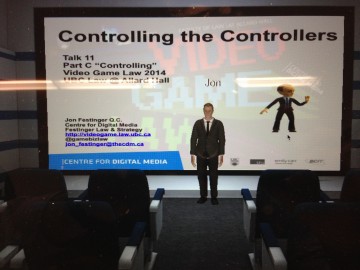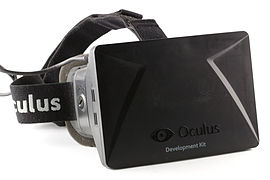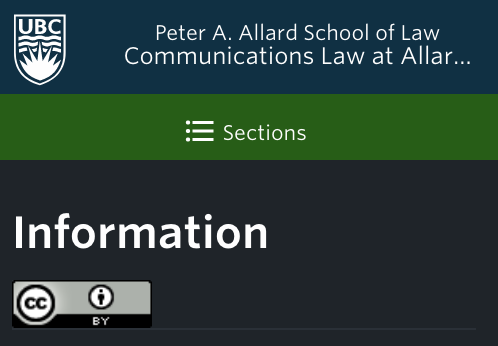

Our class experiment with Oculus Rift DK2’s went smoothly thanks Jesse Joudray of VRChat LLC. Seven participating students equipped with Oculus Rifts’ took in the class from an entirely different part of the law school, while the rest of us remained in our usual class room (B101 of Allard Hall). You can check out (or re-live) what the “Rift students” saw and heard without a 3D headset from the YouTube video you will find in this post. My already pronounced tendency to speak with my hands is certainly raised to new heights (or depths) through the joint efforts of animation and motion capture!
As can be seen from the various comments below, the “Oculus classroom” turned out to be a real success. No one really knew how things were going to go, and the experiment was just that – an experiment. What became clear is that immersive 3D devices have the potential to really work in an educational context. The day may one day come where schools are libraries, offices and common meeting places with most classrooms being virtual because learning actually happens better that way. We are far from that place right now, but before this experiment such a future seemed like pure science fiction. It does not anymore.
There are many obvious things that need to be addressed from a student perspective. These include note taking mechanisms as well as effective and direct (underline “direct”) ways to ask questions so as to fully and equally participate in the “real” classroom setting. If simple and intuitive technological means to resolve these issues are found, then access to education can be expanded in meaningful ways.
A couple of notes from the perspective of the instructor in this experiment.
My only interaction with the “Oculus class” was that I had a monitor not far away through which I could see my virtual students. Aside from my endless amusement that law students would not initially occupy the first row of seats in even a fully virtual classroom, there was nothing in the experiment which affected my teaching. I simply taught to the “real class” in front of me. At the end of the day it is precisely that piece of the puzzle which will have to grow. Creating meaningful feedback loops is arguably the key challenge in all of education. Accordingly it is not farfetched to suggest that creating feedback loops to and from the Oculus class and among all who participate in a class, no matter where they are physically located, will equally become the key to successful pedagogic implementations.
All this led me to wondering what would happen if I were ever called upon to teach to a class made up entirely of 3D headset users without there being a “real” classroom. In that case, seeing some representation of the facial expressions/reactions of each of the individuals in the virtual class feels to me to be a necessity for effective teaching. Achieving that might be possible, even today, if Kinect technology were to be used and the appropriate code written. However the headset device might have to look quite different and there would no doubt be some challenging design problems. When practical and elegant solutions to this problem are found we may truly be on our way…
The reactions from those participating came as a wonderful and heartening surprise. We should all look forward with some optimism to the chapters yet to be written about educational uses of 3D immersive technologies.
jon
 Communications Law
Communications Law
I loved participating in the class through the Rift, particularly watching Jon’s avatar’s funky moves. It was also a lot of fun to be able to see the other students – sometimes diligently paying attention, occasionally getting up to explore the room, run around, or jump on a chair. I was perfectly able to understand the content of the lecture; the only thing was that occasionally I could not read the smaller font on the virtual slides (but knowing I’d be able to look them up later, this wasn’t a concern).
My clumsy attempts to sit down made me feel slightly nauseous (could also have been due in part to going up and down stairs exploring Zelda’s castle before the class began), but this abated after a few minutes of standing quietly in the back and focusing on the lecture. Afterwards I had a very slight headache but this too abated within an hour or two of taking off the headset.
All in all a really fun experience, a class I definitely won’t forget, and something I would absolutely do again!
I’m thrilled to have had a chance to participate in this class. I was surprised by how compelling it was. While the graphics were akin to games of the 90s, the simple ability to move my head to explore different aspects of my world made it very compelling. Here are a few of my impressions:
1) I found experiencing the class in VR to be almost as engaging as being in a classroom. Unlike watching a class video on youtube, I didn’t find myself getting distracted by things outside my window, or snacks waiting in my fridge. Being entirely immersed in the environment also removed distractions of news and FB which might exist in a classroom.
2) The immersive environment had some drawbacks. I couldn’t type notes. Also, often in class, if Jon mentions something I’m unfamiliar with, I’ll often do a quick wikipedia search. In the VR environment I didn’t have this ability to look to resources outside the classroom
3) I kept wanting to get out of my digital seat and stretch my virtual legs – a feeling I sometimes have in normal classes. I found this strange.
4) Bringing in thoughts of the ‘magic circle,’ I was conflicted in how to act in the classroom. It’s not a real classroom, so why sit in the chair? Why not walk up to Jon and see what’s in his digitally rendered head? Why not muck-about and see if I can jump off chairs? I definitely thought about doing all these things, but I was concerned I’d be a digital distraction, and that it would be inappropriate. I also wanted to move up to the front row so I could get a better look at the fancy footwork that Jon was doing, but again, I was worried about interrupting the learning experience of others. The result is that in this VR world, at least for me, social norms and expectations remained the same.
5) I did find the VR tiring at times. It didn’t cause nausea, I could watch and read the screen, but I found myself closing my eyes and treating the experience more as a podcast, occasionally opening them to see if things had changed. This isn’t to say that VR isn’t enjoyable, but I did find myself wanting to see the real world in full resolution.
Those are my two cents.
Thank you so much to Jon, Jesse and Graham for letting us try out the Rifts! It was probably the most memorable lecture I’ll ever have and incredibly cool to experience this technology.
I got to the class a little early so spent some time exploring a few of the “rooms”. The thing that really struck me was that when you moved your head you had a 360 degree view, just like real life. It sounds obvious, but I had never realised how constricted you are when you have to toggle to look around. Another notable thing was when I looked down I could see my virtual body (including my headless shoulders if I looked behind – a little disconcerting to say the least). Having a “body” really made the whole experience more immersive and real: when I walked through a floating butterfly in Zelda’s courtyard I almost felt a shiver and oddly when I sat in my virtual chair I felt more rested.
When I game I’m always interested in finding out what are the boundaries of what I can do. Can I climb that tower? Can I swim to that shipwreck? Or can I jump up and down on my virtual chair in the classroom without the professor telling me off? Sorry if I distracted anyone – I really didn’t mean to! I definitely treated it as a magic circle because I knew other people in the real classroom couldn’t see what I was doing. That said, although I treated the classroom in a way I never normally would I treated other people in the class in a normal way. I think this was because although I knew there would be no implications for me jumping on virtual chairs, the magic circle did not extend where real people were involved. In addition, if the other people in the class or Jon had been able to see my misbehaviour I would have sat quietly in my chair! I suppose I agree with Mia Consalvo in her 2009 article, “Players have real lives, with real commitments, expectations, hopes and desires”. It’s interesting that even in a completely virtual environment, if there were any type of real life repercussions I would have conformed to societal norms straightaway. (There’s definitely #gamergate implications here but that’s a different kettle of fish!)
Thanks to Jon and everyone who participated in this exercise!
There are two major points of learning that have come from it that are specific to education rather than VR or the avatars/animations provided.
1. People are able to absorb the information presented! This was the biggest test. Without this we’re wasting our time. With it, I think we can predict a future for VR in education.
2. People want to take notes. This seems obvious in hind-sight but it hasn’t popped up in our other use-cases. The solution to this problem seems to involve seeing in the real world. Perhaps a dim window under the lenses of the VR Headset that would allow you to focus on your desk would suffice. Or maybe it should be a tablet that’s connected to the app that allows you to scribble notes with a stylus and see your notes in the VR environment. We’ll have to keep thinking about that.
There are definitely some social elements that are emerging in VR that were less relevant in other digital worlds. Personal space should be respected. It freaks people out when someone else gets too close. It was interesting that for a long time no-one chose to sit in the front row in the virtual classroom. Acting up in class was something that fell in the middle. Some people felt no reservations about moving around in a way that, in reality, would be considered disruptive. For others great attention was paid to minimize disruption.
I hope we get an opportunity to do a second run in VR in the near future when we have some new ideas to improve the experience.
Cheers, and thanks again.
Jesse Joudrey
jesse@vrchat.net
I would like to echo everyone’s sentiments and thank Jon and the VR Chat team for giving me the opportunity to try out Oculus.
It was an incredibly immersive experience. The first ‘wow’ moment I had was when I tried Half Life 2. In a first person shooter game, you are playing the game as the protagonist, but there’s still dissonance between you and the character; you still feel you are controlling a character through the screen. With the oculus, I truly felt that I was the protagonist and characters were directly interacting with me.
I think the dissonance/resonance you feel with the avatar you control will be important in whether the virtual reality will provide a higher learning experience or be just a distraction. I was part of a virtual class before; it was like being in a sims game, where you control an avatar in third person view. Most people in the game were fooling around, and I did not find the experience useful as I thought the technology felt forced.
With the VR Chat, there was still some dissonance between you and the avatar that you would be doing things you wouldn’t normally do in a regular class (eg. jumping around), but enough resonance, your social predilection was reflected on the avatar (eg. refusing to sit in first row). I am really excited to see how the learning experience can be improved with the help of Oculus!
Here’s a quick copy-paste of an email exchange I had with Jon. It started off on a totally different topic; and, as email discussions have a propensity to do, it shifted topics — in this case, to topics related to the virtual classroom. I’m sure people who actually experienced the Oculus could expand significantly on this exchange.
EMAIL 1: Jon to Ryan
I was interviewed about the Oculus experiment and whether I thought it had practical uses in education […] saying that I hoped that such immersive technology might allow students who are sick but hate to miss class to have the best of both worlds and get better without missing much.
EMAIL 2: Ryan to Jon
Using the Oculus for “attending” class when sick is a really interesting idea […] I think there would be two key challenges to overcome:
1. Having some ability to ask questions remotely would be a significant advantage. I wonder if it could be as simple as having the ability to send a typed question to the professor’s computer? Or, could something like a teleconference be more appropriate? I guess one of the primary challenges is coming up with a good interface to allow the student even to indicate that they have a question (i.e., the remote equivalent of raising your hand when you’re in an immersive environment, but physically at home).
2. The motion sickness aspect. I didn’t try the Oculus for the VGL class, so I can’t comment on how serious a concern this would be. But, as someone with a propensity to experience motion sickness, I know that I’m a lot more likely to experience motion sickness if I’m not feeling well for other reason already (e.g., tired, hungry, ill, etc.). That’s why two of my worst triggers are bus rides in the summer (extremely hot and stuffy, then the driver starts swerving through traffic) and flights (spending hours in an airport at inhuman times of the morning, screaming children seemingly everywhere, bad airport food, and then comes takeoff). I think it would be interesting to see what sort of effect illness would have with respect to motion sickness and the Oculus — would someone who is ill, but otherwise physically comfy (“attending” class while resting on their couch under a comfy blanket with their teddy bear) be more predisposed to the motion sickness effects than a control (i.e., non-ill) person?
You could even change that question up and ask would an ill person — even potentially experiencing motion sickness with the Oculus — be more comfortable (i.e., have a better learning experience) at home, when compared to that student being in the real classroom […]
Ultimately, I think that being able to “be” in a class that you might otherwise miss or be quite uncomfortable in would be an entirely real (not just theoretical) benefit.
EMAIL 3: Jon to Ryan
[…] Would add that students need to be able to type on their own computers so somehow that needs to be accommodated (head-up display?). Also from an instructors perspective there needs to be much more feedback form the virtual room.
EMAIL 4: Ryan to Jon
With respect to students being able to type, there would have to be some sort of modal method of interaction that allows students to type both (a) their own notes; and, (b) a question to the professor. It could be as simple as hitting some esoteric key combination to switch from typing their own notes to typing a question to the professor.
I suspect, with no actual data to back it up, that the ability for students to touch-type is far less a concern in 2014 than it would have been in 2004, especially with a HUD-style display in the Oculus to show students what they are typing (both for their own notes and when they are asking a question of the professor).
For feedback to the instructor, I have this vision of a professor having a monitor at a ~45deg angle to the students present in-class, showing the “virtual” classroom with avatars of the students who aren’t physically present. If a virtual student wants to ask a question, they could glow or blink or something similar, alerting the professor. The prof could then click on that student’s avatar to see the question they had typed.
There are already quite a few distance education courses being given across higher education worldwide. From everyones reaction there seems little downside and quite a bit of upside to incorporating Rifts into those experiences. Maybe I’m just old school but I have a hard time seeing the physical classroom completely replaced, but for the first time am forced to concede it as a theoretical possibility.
jon
I had a question for the people who did the Oculus rift portion, since I could see the computer of the guy handling it in our room. It looked like there were “students” sitting in seats for the computer POV; were you actually in one of the seat, or did you have the same viewpoint from the back as we did? I know one of the comments above said you could look down at your body; could you also see other students?